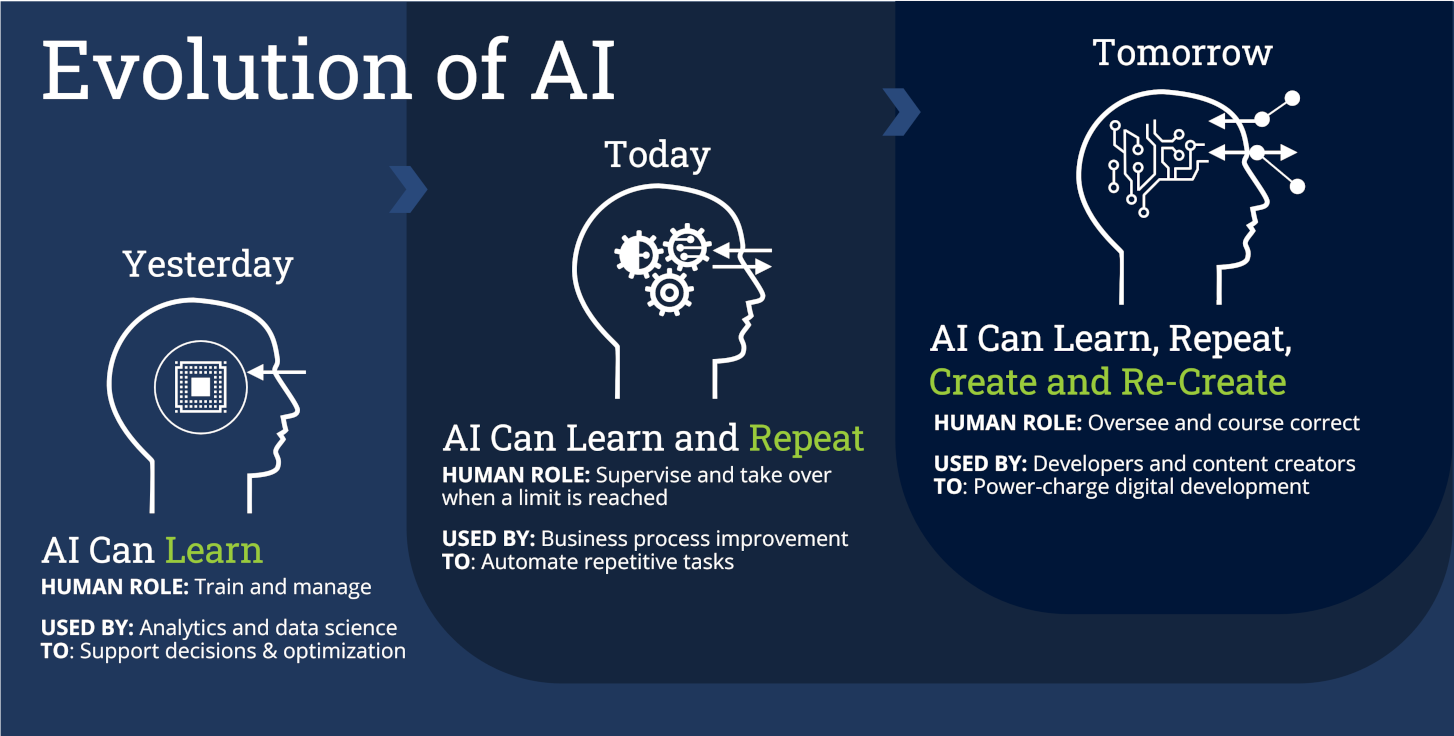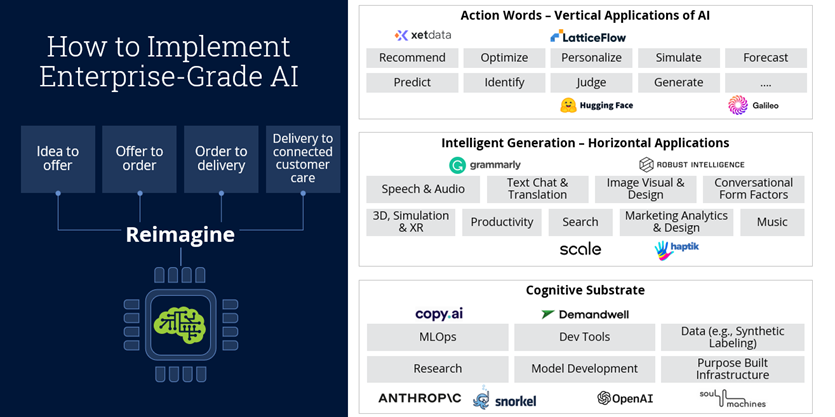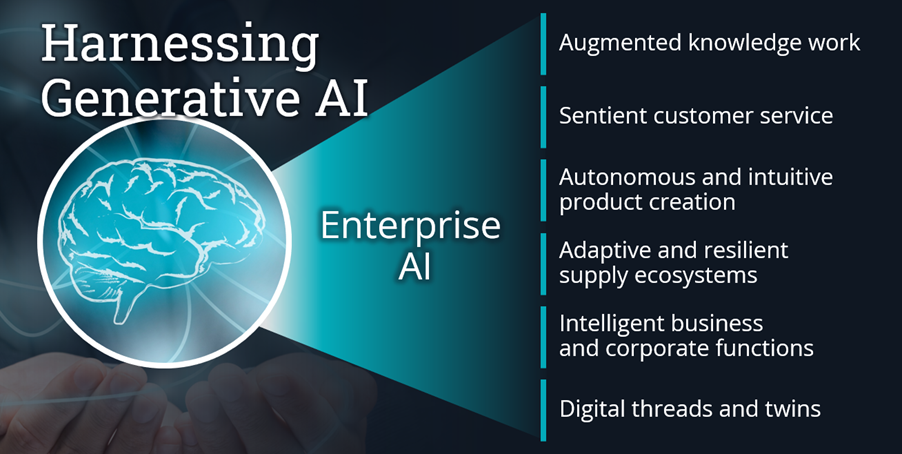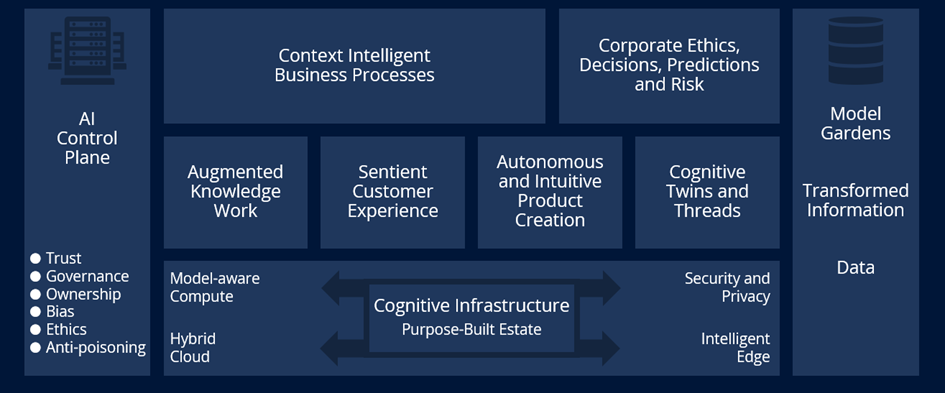We don't need more breathless articles extolling the virtues of ChatGPT and generative AI or doomsday editorials feeding the hysteria and panic about AI taking over the world.
Enterprises need practical information and a plan for going forward. They need to create a strategy that will help them think about enterprise-grade AI (including generative AI) over the next three to five years and design an implementation architecture that will best serve their ambitions iteratively.
Enterprise-Grade AI Is in a New Phase
The evolution of AI made significant strides in achieving enterprise-grade quality when deep learning emerged in the mid-2010s. Deep learning powers a host of AI models capable of achieving new levels of accuracy while balancing the demand on the computational resources required to train them. Enterprise applications across various verticals – from retail to finance and healthcare – now include deep learning capabilities.
Generative AI, which learns the patterns and structure of its input training data and then generates new data, is poised to make an even more significant impact on the enterprise. But what is new and why now?
Generative AI can produce incredibly complex datasets on its own. Unlike traditional machine learning (ML) models, generative AI features ML in a manner that enables the creation of fresh and diverse output data without needing to be labeled with pre-defined data sets.

Figure 1: The Evolution of AI
Because the evolution of AI is having – and will continue to have – such a profound impact on human work, it cannot be seen solely through the lens of technology. It should be seen instead through the lens of human augmentation.
The evolution of AI to date includes three main phases: yesterday, today and tomorrow.
Yesterday – AI can learn: Early AI models could learn by assimilating data into static algorithms to recognize patterns, but these early models needed human training and management. This drove narrow usage, which was largely limited to predicting, judging and optimizing decisions.
Today – AI can learn and repeat: Driven by advancements in machine learning and neural networks, today's AI has evolved to learn and repeat tasks. It’s no longer a passive observer; it actively engages, interprets and replicates data inputs. Because of this evolution, the role of the human has changed; the human now supervises and takes over when the model reaches a limitation. This unleashed new capabilities in intelligent automation that can address business process improvement and speed up repetitive tasks.
Tomorrow – AI can create: The advent of generative AI promises a new era of creativity, with the technology’s capacity to learn, repeat, create and recreate. Fueled by generative models, the next chapter of AI evolution will foster innovation and new possibilities, not just mimicking human intelligence but enhancing it, providing unforeseen solutions, breaking boundaries and pioneering an era of unprecedented technological evolution.
With this change will come change in the role of the human, too. Workers who use AI will oversee and course correct as needed. AI will move from augmenting business processes to augmenting humans in their creative endeavors. AI will now power creative organizational functions that focus on developing products and offerings.
Thinking about AI in Terms of Actions
The most intuitive way to think about AI at enterprise scale is to think in terms of verbs – the actions it can take to enable and augment business functions.
Much like human cognition, AI capabilities can be encapsulated by verbs:
- Learn – its ability to absorb and process data
- Predict – its ability to forecast outcomes based on patterns
- Create – its ability to generate new ideas
- Judge – its ability to evaluate
- Simulate – its ability to mimic complex scenarios and aid in problem-solving and innovation
These verbs provide a comprehensive list that describes the multifaceted nature of artificial intelligence.

Figure 2: Thinking about AI in Terms of Action Words
To gain real momentum from an AI strategy, organizations should pivot away from planning business function transformations to thinking about how AI can augment a human in terms of verbs.
Harnessing Generative AI for Enterprise Value
Organizations have already built strategies for AI / ML. These will have to expand. Generative AI will not only change the way businesses operate, it will also open up new avenues for creativity, productivity and reimagination.
With the ability to learn, adapt, create and recreate, the technology isn't just evolving in sophistication; it is evolving how we envision and navigate the future of enterprises.

Figure 3: Six ways enterprises can harness generative AI
We see generative AI having an impact in six realms of the typical G1000 enterprise:
- Product creation – AI will enhance creative design and production processes and predict market trends and user needs.
- Cognitive digital threads and digital twins – AI will supercharge connected products in the form of digital twins. And take those lessons into digital threads: cognitive data flows across the lifecycles of knowledge and physical products, from design and manufacturing / creation to maintenance and decommissioning; AI-enhanced simulations and predictions will optimize processes and experiences.
- Knowledge work – AI will enhance knowledge work by generating original ideas, designs and solutions and will empower creative professionals by simulating various outcomes of creative strategies and arming them with greater insight and efficiency.
- Customer service – AI will make automated customer service seem more sentient by predicting and understanding customer needs, responding to them in real-time, personalizing interactions and even emulating human-like conversation.
- Supply ecosystems – AI will boost resilience by anticipating supply chain disruptions, suggesting preventive measures and generating contingency plans; it will optimize logistics by creating efficient routes and schedules; and it will build flexibility by adapting in real-time to changing conditions, such as sudden demand fluctuations or logistical complications, and making necessary adjustments to maintain smooth operations.
- Business and corporate functions – AI will revolutionize business functions by automating and enhancing decision-making processes, analyzing massive volumes of data, generating insights and proposing strategic directions or solutions. In HR, for instance, it will predict hiring needs, create job descriptions or identify the best candidates. In finance, it will forecast trends, simulate different financial scenarios and suggest optimal strategies. In marketing, it will create and test different campaign strategies, generate content and personalize customer experiences.
How to Implement a Reference Architecture for Enterprise-Grade and Generative AI
In the previous section, we discussed the six realms in the enterprise where AI will generate new business value. To make the most of all that is possible in these realms, companies need an AI strategy.
We recommend the following implementation architecture for enterprise-grade AI and generative AI.

Figure 4: The ISG Reference Model for AI Adoption to Guide the Sequence of Adoption and Design Dependencies
As attention shifts from the current ways people use AI to a need for continuous course correction, the enterprise will likely see more risk. Establishing an AI control plane that is supported by a risk-aware and ethical function that guides decisions and predictions will become increasingly important.
Emerging concepts like “model gardens” are acting as repositories or libraries of pre-trained models to make sure enterprises incorporate four components: augmented knowledge work, sentient customer experience, autonomous and intuitive product creation and cognitive twins and threads. Technology providers will offer diverse, ready-to-deploy models, aiding quick experimentation and implementation. They can streamline model management, enable model versioning, facilitate collaboration and accelerate AI development. Essentially, the right partners for an enterprise will transform the way AI practitioners navigate the lifecycle of AI models.
To enable this, companies will need purpose-built infrastructure estates that can drive AI and cognitive needs. This ecosystem will need to be scalable, agile and robust and optimized for data-intensive operations and machine learning tasks. An effective infrastructure will incorporate high-performance compute resources, large-scale storage solutions and high-speed networking to support AI workloads and ensure seamless data flows and real-time analytics.
The reference architecture will have four attributes. It will:
- Be layered with advanced security measures to protect sensitive information.
- Be flexible enough to support both on-premises and cloud-based operations, so it can enable enterprises to scale AI applications as needed.
- Facilitate integration and interoperability between different systems and tools, so it can fully foster collaboration and innovation.
- Be the backbone supporting the adoption and optimization of AI in enterprises.
How Enterprises Should Navigate the AI Journey – Not Alone
The advent of generative AI signifies a new dawn for enterprises. As this transformative technology learns, adapts, creates and recreates, it can foster an environment in which problem-solving transcends conventional boundaries and creativity flourishes.
On the AI journey, enterprises must continually evolve. Finding the right partners for this journey has never been more critical. Most organizations need help harnessing the power of AI to navigate change, seize opportunities and redefine success. We can help you find the right partners. Contact us to find out how we can get started.
